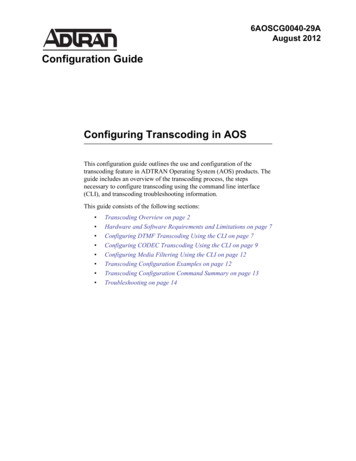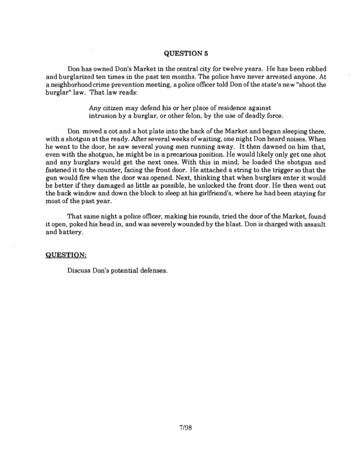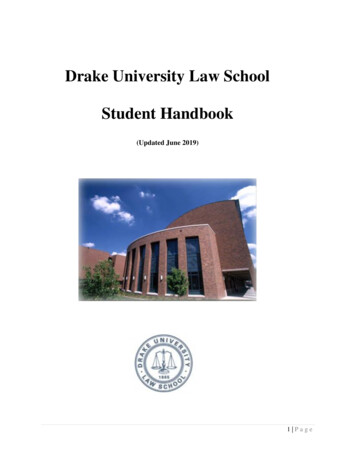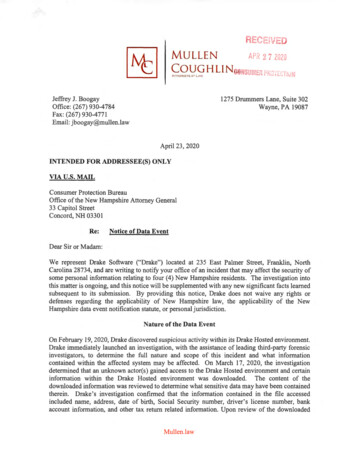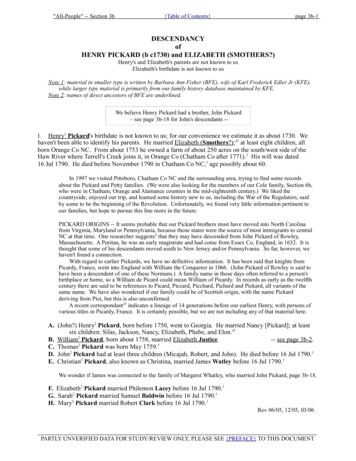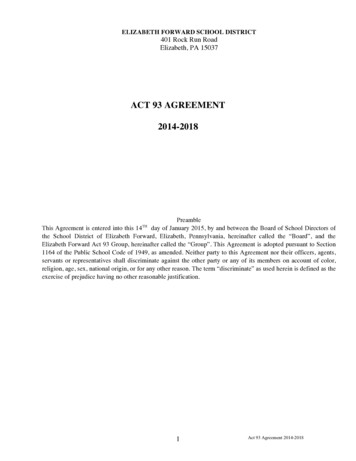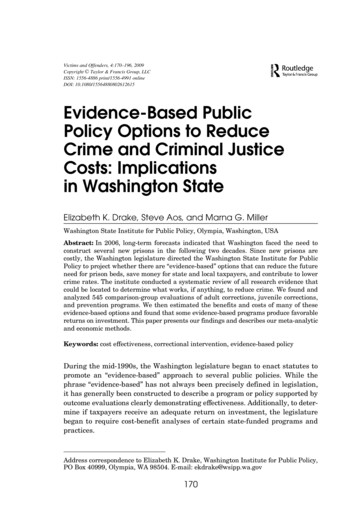
Transcription
Victims and Offenders, 4:170–196, 2009Copyright Taylor & Francis Group, LLCISSN: 1556-4886 print/1556-4991 onlineDOI: 10.1080/15564880802612615Evidence-Based PublicPolicy Options to ReduceCrime and Criminal JusticeCosts: Implicationsin Washington State1556-49911556-4886UVAOVictimsand OffendersOffenders, Vol. 4, No. 1, November 2008: pp. 1–35PublicE.K. Drake,Policy S.OptionsAos, and M. G. MillerElizabeth K. Drake, Steve Aos, and Marna G. MillerWashington State Institute for Public Policy, Olympia, Washington, USAAbstract: In 2006, long-term forecasts indicated that Washington faced the need toconstruct several new prisons in the following two decades. Since new prisons arecostly, the Washington legislature directed the Washington State Institute for PublicPolicy to project whether there are “evidence-based” options that can reduce the futureneed for prison beds, save money for state and local taxpayers, and contribute to lowercrime rates. The institute conducted a systematic review of all research evidence thatcould be located to determine what works, if anything, to reduce crime. We found andanalyzed 545 comparison-group evaluations of adult corrections, juvenile corrections,and prevention programs. We then estimated the benefits and costs of many of theseevidence-based options and found that some evidence-based programs produce favorablereturns on investment. This paper presents our findings and describes our meta-analyticand economic methods.Keywords: cost effectiveness, correctional intervention, evidence-based policyDuring the mid-1990s, the Washington legislature began to enact statutes topromote an “evidence-based” approach to several public policies. While thephrase “evidence-based” has not always been precisely defined in legislation,it has generally been constructed to describe a program or policy supported byoutcome evaluations clearly demonstrating effectiveness. Additionally, to determine if taxpayers receive an adequate return on investment, the legislaturebegan to require cost-benefit analyses of certain state-funded programs andpractices.Address correspondence to Elizabeth K. Drake, Washington Institute for Public Policy,PO Box 40999, Olympia, WA 98504. E-mail: ekdrake@wsipp.wa.gov170
Public Policy OptionsWashington’s initial experiments with evidence-based and cost-beneficialpublic policies began in the state’s juvenile justice system. The legislature fundedseveral nationally known and well-researched programs designed to reducethe reoffending rates of juveniles. At the same time, the legislature eliminatedthe funding of a juvenile justice program when a careful evaluation revealed itwas failing to reduce juvenile crime. Following this initial successful ventureinto evidence-based public policy, Washington began to introduce the approachto other areas including child welfare, mental health, substance abuse, K–12education, and adult corrections.In 2005, long-term forecasts indicated that Washington would need twonew prisons by 2020 and possibly another by 2030. That year’s legislaturedirected the institute to determine if evidence-based options existed that couldreduce the need for prison construction, save money for state and local taxpayers,and contribute to lower crime rates (Capital Budget, 2005). We conducted asystematic review of all the research evidence we could locate in adult corrections,juvenile corrections, and prevention programs and found that some evidencebased programs reduce crime while others do not; we also conducted an economicanalysis of many of the programs (Aos, Miller, & Drake, 2006).Based on the findings, the 2007 legislature made significant investmentsby allotting 48 million in the biennial budget for the expanded use of evidencebased programs. Investments were made in many adult and juvenile justiceprograms, as well as in prevention programs—including drug treatment, education, vocational training, correctional industries, functional family therapy,multisystemic therapy, aggression replacement training, and early childhoodeducation. The state’s prison forecast was subsequently adjusted downward toreflect the resource decisions made by the 2007 legislature.In this paper, we present the findings from our 2006 study, including somerevisions since its publication. This research is part of an ongoing effort toimprove Washington’s criminal justice system; the narrative presented here is asnapshot of the current analytical process. Due to space limitations, we focuson our statistical review of the evaluation literature and on our per-programeconomic analysis. We do not include our estimates of the aggregate impactsof evidence-based programs on forecasted prison populations or statewide crimerates.We proceed in two steps. The first step addresses the question: What works?Specifically, do rigorous evaluations indicate that some adult corrections programs, juvenile corrections programs, or prevention programs lower crime rates?To answer this fundamental question, we employ a systematic review of theresearch and use meta-analytic procedures to evaluate the evidence.While the purpose of the first step is to determine if anything works tolower crime outcomes, in the second step we ask a follow-up question: Per dollarspent on a program, do the benefits of the program’s crime reduction exceedits costs? Since all programs cost money, this additional economic test seeks to171
172E. K. Drake, S. Aos, and M. G. Millerdetermine whether the amount of crime reduction justifies the program’sexpenditures. A program may have demonstrated an ability to reduce crime but,if the program costs too much, it may not be a good investment—especiallywhen compared with alternatives including incarceration. We describe theeconomic model we have developed to predict how much money is spent orsaved in Washington when crime goes up or down.META-ANALYTICAL PROCEDURESTo estimate the benefits and costs of different approaches to reduce and prevent crime, we conducted separate meta-analyses of the relationship betweenevaluated programs and crime. In this section, we describe our procedures forsearching for, including, and coding studies—along with the statistical methodswe used to estimate the weighted average effects of a program.Search StrategyWe searched for all adult and juvenile corrections and prevention evaluationstudies conducted since 1970 that are written in English. We used three primarymeans to identify and locate these studies: (a) we consult the study lists ofother systematic and narrative reviews of the adult and juvenile correctionsand prevention research literature; (b) we examine the citations in the individualevaluations; and (c) we conduct independent literature searches of researchdatabases using search engines such as Google, Proquest, Ebsco, ERIC, andSAGE. We obtained and examined copies of all individual program evaluationstudies we could locate using these search procedures.Many of these studies were published in peer-reviewed academic journals,while others were from government reports obtained from the agencies themselves. It was important to include non–peer reviewed studies, because it hasbeen suggested that peer-reviewed publications may be biased to show positiveprogram effects (Lipsey & Wilson, 2001). Therefore, our meta-analysis includesall available studies we could locate regardless of published source.Criteria for Inclusion and Exclusion of StudiesComparison group. The most important inclusion criterion in our systematicreview of the literature was that an evaluation must have a control or comparisongroup. We did not include studies with a single-group, pre-post research design inorder to avoid false inference on causality (Coalition for Evidence-Based Policy,2003). Random assignment studies were preferred for inclusion in our review,but we also included nonrandomly assigned control groups. We only includedquasiexperimental studies if sufficient information was provided to demonstrate reasonable comparability between the treatment and comparison groupson important pre-existing conditions such as age, gender, and prior criminal
Public Policy Optionshistory. Of the 545 individual studies in our review, about 4% involved effectsestimated from well-implemented random assignment studies.Participant sampling procedures. We did not include a study in our metaanalytic review if the treatment group was made up solely of program completers.We adopted this rule to avoid unobserved self-selection factors that distinguish a program completer from a program dropout; these unobserved factorsare likely to significantly bias estimated treatment effects (Lipsey, 2003).Some comparison group studies of program completers, however, containedinformation on program dropouts in addition to a comparison group. In thesesituations, we included the study if sufficient information was provided toallow us to reconstruct an intent-to-treat group that included both completersand noncompleters, or if the demonstrated rate of program noncompletion wasvery small (e.g., under 10%). In these cases, the study still needed to meet theother inclusion requirements listed here.Outcomes. A crime-related outcome had to be reported in the study to beincluded in our review. Some studies presented several types of crime-relatedoutcomes. For example, studies frequently measured one or more of the following outcomes: total arrests, total convictions, felony arrests, misdemeanorarrests, violent arrests, and so on. In these situations, we coded the broadestcrime outcome measure. Thus, most of the crime outcome measures that wecoded are total arrests and total convictions. When a study reported both totalarrests and total convictions, we calculated an effect size for each measureand then took a simple average of the two effect sizes.Some studies included two types of measures for the same outcome: a dichotomous outcome and a continuous (mean number) measure. In these situations,we coded an effect size for the dichotomous measure. Our rationale for thischoice was that in small or relatively small sample studies, continuous measuresof crime outcomes can be unduly influenced by a small number of outliers, whiledichotomous measures can reduce this problem (Farrington & Loeber, 2000).Of course, if a study only presented a continuous measure, we coded the continuous measure.When a study presented outcomes with varying follow-up periods, we generally coded the effect size for the longest follow-up period. This allowed us togain the most insight into the long-run benefits and costs of various treatments.Occasionally, we did not use the longest follow-up period if it was clear that alonger reported follow-up period adversely affected the attrition rate of thetreatment and comparison group samples.Miscellaneous coding criteria. Our unit of analysis was an independent testof a treatment at a particular site. Some studies reported outcomes for multiplesites; we included each site as an independent observation if a unique and independent comparison group was also used at each site.Some studies presented two types of analyses: raw outcomes that were notadjusted for covariates such as age, gender, or criminal history; and those that173
174E. K. Drake, S. Aos, and M. G. Millerhad been adjusted with multivariate statistical methods. In these situations,we coded the multivariate outcomes.Procedures for Calculating Effect SizesCalculations for dichotomous and continuous outcomes. Effect sizes measurethe degree to which a program has been shown to change an outcome for programparticipants relative to a comparison group. In order to be included in ourreview, a study had to provide the necessary information to calculate an effectsize. Several methods can be used by meta-analysts to calculate effect sizes.We used the standardized mean difference effect size for continuous measuresand the D-cox transformation as described in Sánchez-Meca, Chacón-Moscoso,and Marín-Martínez (2003, Equation 18) to approximate the mean differenceeffect size for dichotomous outcome variables. P (1 pc ) dCox ln e / 1.65 Pc (1 pe ) (1)In Equation 1, dcox is the estimated effect size, which is derived by dividing the log odds ratio by the constant 1.65. Pe represents the percentage outcome for the experimental or treatment group and Pc is the percentageoutcome for the control group.For continuous outcome measures, we used the standardized mean difference effect size statistic (Lipsey & Wilson, 2001, table B10, Equation 1).ESm Me McSDe2 SDc22(2)In the second equation, ESm is the estimated standardized mean effectsize where Me is the mean outcome for the experimental group, Mc is the meanoutcome for the control group, SDe is the standard deviation of the mean outcomefor the experimental group, and SDc is the standard deviation of the meanoutcome for the control group.Sometimes research studies reported the mean values needed to computeESm in Equation 2, but they failed to report the standard deviations. Often,however, the research reported information about statistical tests or confidenceintervals that could then allow the pooled standard deviation to be estimated.These procedures are further described in Lipsey and Wilson (2001).Some studies had very small sample sizes, which have been shown toupwardly bias effect sizes—especially when samples are less than 20. Therefore,we followed Hedges (1981) and Lipsey and Wilson (2001, Equation 3.22) andreport the “Hedges correction factor,” which we used to adjust all mean difference
Public Policy Optionseffect sizes (N is the total sample size of the combined treatment and comparisongroups).3 ESm [ESm , or, dcox ]′ 1 4 N 9 (3)Techniques Used to Combine the EvidenceOnce effect sizes were calculated for each program effect, the individualmeasures were summed to produce a weighted average effect size for a program area. We calculated the inverse variance weight for each program effectand these weights were used to compute the average. These calculationsinvolved three steps. First, we calculated the standard error of each meaneffect size. For continuous outcomes, the standard error, SEm, was computedwith (Lipsey & Wilson, 2001, Equation 3.23)SEm ne nc( ES’ m )2 2(ne nc )ne nc(4)In Equation 4, ne and nc are the number of participants in the experimental and control groups and ES'm is from Equation 3.For dichotomous outcomes, the standard error, SEdcox, was computed with(Sánchez-Meca et al., 2003, Equation 19) 1111 SEdCox 0.367 O1 E O2 E O1C O2C (5)In Equation 5, O1E and O1C represent the success frequencies of the experimental and control groups. O2E and O2C represent the failure frequencies ofthe experimental and control groups.The second step in calculating the average effect size for a program areawas to compute the inverse variance weight, wm, for each mean effect sizewith (Lipsey & Wilson, 2001, Equation 3.24)wm 12SEm(6)The weighted mean effect size for a group of studies was then computedwith (Lipsey & Wilson, 2001, p. 114)ES (wmES ′m ) wm(7)175
176E. K. Drake, S. Aos, and M. G. MillerFinally, confidence intervals around this mean were computed by first calculating the standard error of the mean with (Lipsey & Wilson, 2001, p. 114)SEES 1 wm(8)The lower, ESL, and upper, ESU, limits of the confidence interval were computed with (Lipsey & Wilson, 2001, p. 114)ESL ES z(1 a ) (SEES )(9)ESU ES z(1 a ) (SEES )(10)In Equations 9 and 10, z(1-α) is the critical value for the z-distribution.Techniques Used to Assess HeterogeneityComputing random effects weighted average effect sizes and confidenceintervals. Once the weighted mean effect size was calculated, we tested forhomogeneity. This provides a measure of the dispersion of the effect sizesaround their mean and is given by (Lipsey & Wilson, 2001, p. 116)Q ( w ES2 ) ( wES)2 w(11)The Q-test is distributed as a chi-square with k-1 degrees of freedom(where k is the number of effect sizes). When the p-value on the Q-test indicates significance at values of p less than or equal to .05, a random effectsmodel was performed to calculate the weighted average effect size. This wasaccomplished by first calculating the random effects variance component, v(Lipsey & Wilson, 2001, p. 134).v Q (k 1)w ( wsq w)(12)This random variance factor was then added to the variance of each effectsize and all inverse variance weights were recomputed, as were the othermeta-analytic test statistics.Adjustments to Effect SizesMethodological quality. Not all research is of equal quality and this greatlyinfluences the confidence that can be placed in interpreting the policy-relevant
Public Policy Optionsresults of a study. Some studies are well-designed and implemented and theresults can be reasonably viewed as causal effects. Other studies are notdesigned as well and less confidence can be placed in the causal interpretationof any reported differences. Studies with inferior research designs cannot completely control for sample selection bias or other unobserved threats to thevalidity of reported research results. This does not mean that results fromthese studies are of no value, but it does mean that less confidence can beplaced in any cause-and-effect conclusions drawn from the results.To account for the differences in the quality of research designs, we used a5-point scale as a way to adjust the raw effect sizes. The scale is based closelyon the 5-point scale developed by researchers at the University of Maryland(Sherman et al., 1998, chap. 2). On the 5-point scale as interpreted by ourinstitute, each study was rated with the following numerical ratings.A “5” was assigned to an evaluation with well-implemented randomassignment of subjects to a treatment group and a control group that does notreceive the treatment/program. A good random assignment study should alsoreport how well the random assignment actually occurred by reporting valuesfor pre-existing characteristics for the treatment and control groups.A “4” was assigned to a study that employed a rigorous quasiexperimentalresearch design with a program and matched comparison group, controllingwith statistical methods for self-selection bias that might otherwise influenceoutcomes. These quasiexperimental methods might have included estimatesmade with a convincing instrumental variables or regression discontinuity modeling approach or other techniques such as a Heckman self-selection model(Rhodes et al., 2001). A value of 4 might also be assigned to an experimentalrandom assignment design that reported problems in implementation, perhapsbecause of significant attrition rates.A “3” indicated a nonexperimental evaluation where the program andcomparison groups were reasonably well matched on pre-existing differencesin key variables. There must be evidence presented in the evaluation thatindicated few, if any, significant differences were observed in these salientpre-existing variables. Alternatively, if an evaluation employed sound multivariate statistical techniques to control for pre-existing differences, and if theanalysis was successfully completed and reported, then a study with some differences in pre-existing variables could qualify as a level 3.A “2” involved a study with a program and matched comparison groupwhere the two groups lacked comparability on pre-existing variables and noattempt was made to control for these differences in the study. A “1” involvedan evaluation study where no comparison group was utilized.In our meta-analytic review, we only considered evaluations that rate atleast a 3 on this 5-point scale. We did not use the results from program evaluations rated as a “1” on this scale, because they did not include a comparisongroup and thus provided no context to judge program effectiveness. We also177
178E. K. Drake, S. Aos, and M. G. Millerregarded evaluations with a rating of “2” as highly problematic and, as aresult, did not consider their findings in our analyses.An explicit adjustment factor was assigned to the results of individualeffect sizes based on the institute’s judgment concerning research design quality.The specific adjustments made for these studies were based on our knowledgeof research in particular fields. For example, in criminal justice program evaluations, there is strong evidence that random assignment studies (i.e., level 5studies) have, on average, smaller absolute effect sizes than studies withweaker designs (Lipsey, 2003). We used the following default adjustments toaccount for studies of different research design quality. The effect size of alevel 3 study was discounted by 50 percent and the effect size of a level 4 studywas discounted by 25 percent, while the effect size of a level 5 study was notdiscounted. While these factors were subjective, we believed not making someadjustments for studies with varying research design quality would severelyoverestimate the true causal effect of the average program.Researcher involvement in the program’s design and implementation. Thepurpose of the institute’s work is to identify and evaluate programs that canmake cost-beneficial improvements to Washington’s actual service deliverysystem. There is some evidence that programs closely controlled by researchersor program developers have better results than those that operate in “realworld” administrative structures (Lipsey, 2003; Petrosino & Soydan, 2005).For example, in our evaluation of a real-world implementation of a researchbased juvenile justice program in Washington, we found that the actual resultswere considerably lower than the results obtained when the intervention wasconducted by the originators of the program (Barnoski, 2004). Therefore, wemade an adjustment to effect sizes to reflect this distinction. As a generalparameter, the institute discounted effect sizes by 50 percent for all studiesdeemed not to be “real world” trials.COST-BENEFIT PROCEDURESOnce we conducted the meta-analyses to determine if a program reduces crime ata statistically significant level, we then monetized the benefits to taxpayers andcrime victims of future crimes avoided, and estimated the costs of a program versus the costs of not participating in the program. We then compared the benefitsto the costs in order to determine the bottom-line economics of a program.Criminal Justice System and Crime Victim CostsIn the institute’s cost-benefit model, we estimated the costs of criminaljustice system resources that are paid by taxpayers for each significant part ofthe publicly financed system in Washington. The costs of police and sheriffs,superior courts and county prosecutors, local juvenile detention services, local
Public Policy Optionsadult jails, state juvenile rehabilitation, and state adult corrections were estimated separately in the analysis. Operating costs were estimated for each ofthese criminal justice system components, and annualized capital costs wereestimated for the capital-intensive sectors.The model used estimates of marginal operating and capital costs of thecriminal justice system. In a few cases average cost figures were used whenmarginal cost estimates could not be reasonably estimated. Marginal criminaljustice costs were defined as those costs that change over the period of severalyears as a result of changes in workload measures. For example, when oneprisoner is added to the state adult corrections system, certain variable foodand service costs increase immediately, but new corrections staff are not hiredthe next day. Over the course of a governmental budget cycle, however, newcorrections staff are likely to be hired to handle the larger average daily population of the prison. In the institute’s analysis, these “longer-run” marginalcosts have been estimated—rather than immediate, short-run marginal costs.Costs and the equations used to estimate per-unit marginal operating costscan be found in Aos, Lieb, Mayfield, Miller, and Pennucci (2004).In addition to costs paid by taxpayers, many of the costs of crime are borneby victims. Some victims lose their lives; others suffer direct, out-of-pocketpersonal or property losses. Psychological consequences also occur to crimevictims, including feeling less secure in society. The magnitude of victim costsis very difficult—and in some cases impossible—to quantify.National studies, however, have taken significant steps in estimatingcrime victim costs. One U.S. Department of Justice study by Miller, Cohen,and Wiersema (1996) divides crime victim costs into two types: (a) monetarycosts, which include medical and mental health care expenses, property damageand losses, and the reduction in future earnings incurred by crime victims; and(b) quality of life cost estimates, which place a dollar value on the pain and suffering of crime victims. In that study, the quality of life victim costs were computedfrom jury awards for pain, suffering, and lost quality of life; for murders, thevictim quality of life value was estimated from the amount people spend toreduce risks of death. In the institute’s analysis, victim costs from the Milleret al. study were used as estimates of per-unit victim costs in Washington.Crime Distributions for Offender PopulationsIn order to estimate the long-run effectiveness of programs, we combinedthe effect sizes discussed earlier with other information on offender populations in Washington. We computed recidivism parameters for various offenderpopulations using the institute’s criminal records database. Recidivism wasdefined as any offense committed after release to the community, or after initialplacement in the community, that results in a conviction in Washington. Thisincluded convictions in juvenile and adult court.179
180E. K. Drake, S. Aos, and M. G. MillerWe collected recidivism data on five general populations of offenders whobecame at-risk in the community during calendar year 1990. We selected 1990because that year allowed a 13-year follow-up period to observe subsequentconvictions. A one-year adjudication period was included in the follow-up to allowfor court processing of any offenses toward the end of the 13-year follow-up. Theserecidivism data included the probability of any reoffense, the timing of reoffensesover the 13-year period, the volume of reoffenses, and the type of reoffenses.For adult offenders, we observed the 13-year recidivism patterns for thoseoffenders released from Washington Department of Corrections (DOC) facilitiesin 1990, and those offenders sentenced directly to DOC community supervisionin 1990. For juvenile offenders, we observed the 13-year recidivism patternsfor those offenders released from Washington State Juvenile RehabilitationAdministration (JRA) facilities in 1990, those offenders sentenced to diversionthrough local-sanctioning courts in 1990, and those offenders sentenced todetention/probation through local-sanctioning courts in 1990.These five populations were further broken down by the offender’s most serious current offense category. That is, we computed recidivism information forpopulations based on the most serious offense for which they were convicted priorto the 13-year follow-up period. These categories included drug, property, sex, violent (nonsex), drug and property, violent (sex), misdemeanors, and total felonyand misdemeanor offenses. Thus, we calculated separate crime distributions for40 populations (five offender populations multiplied by eight offense categories).Next, we calculated probability density distributions for each of the 40populations using lognormal, gamma, or weibull distributions, which indicatedwhen convictions were likely to happen over the 13-year follow-up period.From the recidivism data, we also calculated the total number of adjudications and offenses a person had during the follow-up period. Recidivism adjudications and offenses were broken down into the following offense categories:murder, sex, robbery, assault, property, drug, and misdemeanor. Using thisinformation, we then determined the average number of adjudications a personhad through the criminal justice system. In addition, we calculated the averagenumber of offenses per adjudication. Finally, we computed the average timebetween sentences over the follow-up period.For prevention programs, we similarly estimated long-run crime distributions for nonoffender populations by calculating the probability of obtaining aconviction over the life-course. We selected the 1973 birth cohort because thisgave us the longest follow-up period (32 years) possible with Washington criminalrecords data.Criminal Justice System EffectsRelative risk. In order to calculate the benefits of evidence-based programs,first we calculated the degree to which a program was estimated to affect crime,
Public Policy Optionsnotated as relativerisky. This variable indicated the change in the relative riskof being convicted for a crime in year y as a function of the estimated effectsize for a program and the base crime probability for the offender population.Relativerisky is computed ase(ES * 1.65) * Crimeprob 1 - Crimeprob Crimeprob * e(ES * 1.65) relativeRisky 1 Crimeprob (13)* (1 decayrate) yIn Equation 13, using the D-cox transformation we computed the estimated change in outcome of the treatment group as a function of the effectsize, ES, and the long-run recidivism rate for the relevant population, Crimeprob.ES represents the institute-adjusted effect size for each evidence-basedoption, as computed from the meta-analyses described in the previous section. The variable decayrate is a parameter that allowed us to model exponential rates of decay (or growth) in the effect size over time. We put thisfeature in the model because most of the evaluations included in our reviewanalyzed crime outcomes with relatively short follow-up periods, often one ortwo years. In our model, however, we estimated long-run crime curves usinga 13-year follo
172 E. K. Drake, S. Aos, and M. G. Miller determine whether the amount of crime reduction justifies the program's expenditures. A program may have demonstrated an ability to reduce crime but, if the program costs too much, it may not be a good investment—especially when compared with alternatives including incarceration. We describe the


